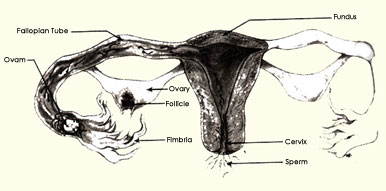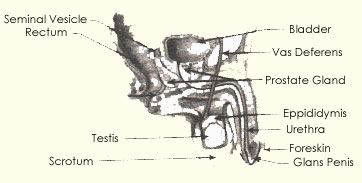Pregnancy begins with conception ( fertilization) and
continues until the moment of birth. It is that special time in
your life when your body envelops the growth of a new being . Everything
you do , everything you eat, and even your emotions may have an
effect on the development of that new life. It is therefore very
important for you to be aware both of the actions that you can take
to most benefit the development of your baby and of the
detrimental factors that you should avoid. Understanding the normal
course of pregnancy will aid you in acquiring this awareness.
Each woman's pregnancy differs in some ways from every
other woman's .In fact, different pregnancies in the same woman
usually vary. However, some aspects of pregnancy are common to all
women. Certain physical and emotional changes, resulting in similar
physical and emotional needs, are seen in every pregnant woman.
Fertilization
A baby is created by the union of an egg cell from a woman's body
and a sperm cell from a man's body, This union is called fertilization
and marks the beginning of pregnancy. Each egg and sperm
cell contains half of the genetic material, or chromosomes,
necessary to begin human life . These chromosomes contain thousands
of sections called genes, which determine the various
characteristics of the child. The women and man each contribute twenty-three
chromosomes to their child, making a total of forty six. Because of
the billions of possible combinations that can be produced by
these forty six chromosomes and their thousands of
genes, every child is unique.

The female reproductive organs where
fertilization take place
The woman's biological contribution begins in one of her
two ovaries. Every month, an egg follicle ripens and
swells in one of the ovaries, This ripening of the egg cell is
initiated by a pituitary hormone. The walls of the follicle
surrounding
the ripening egg produce estrogen, which causes the lining
of the uterus, or womb to thicken ,The estrogen
also causes the cervical mucus to increase and to become more
receptive to sperm, When the egg is mature, it bursts out of the
follicle and is released near the fringed end of the fallopian
tube. The release of an egg from an ovary is called ovulation. Ovulation
usually occurs 14 days before the next menstrual period,
or about midway through the cycle.
The fallopian tubes are muscular canals lined with fine hairs,
called cilia that move with a wavelike action, drawing the egg into
the tube and then through it toward the uterus. (See Figure1) At the same time that the egg is traveling through
the fallopian tube, the follicle, stimulated by a
pituitary hormone, begins producing progesterone,
another hormone, which causes the uterine lining to thicken
further, The progesterone also slows down
contractions in the uterus, which facilitate implantation of
the fertilized egg.
The biological contribution that the man makes the baby
begins with the production of sperm cells in testes,
which are two organs that hang outside his body in a sac
of skin called the scrotum, ( see figure 2) sperm
cells, or spermatozoa, are produced in the somniferous tubules
within the testes and are propelled in the epididymis for
storage until ejaculation . As the spermatozoa pass from
the epididymis through the vas deferens to
the urethra, secretions are added from the seminal vesicles,
the prostate, and Cowper's glands. The purpose of these
secretions is to provide a nourishing and fluid material that
helps the spermatozoa move through the vagina, where
they are deposited during intercourse.

The male
reproductive organs
The penis becomes erect during sexual excitement as
blood pours into layers of spongy material and the veins
leaving the penis begin to constrict. With further excitement
, the muscles around the seminal vesicles, the vas deferens,
and the prostate gland contract, driving the semen into the urethra.
The muscles in the prostate gland contract and push the se en through
the opening of the urethra. About 250 million to 500 million
sperm are ejaculated, although, less than 500 will reach the
egg.
For fertilization to occur , sperm must reach the egg within 24
hours of ovulation. Sperm remain viable for up to 72 hours. It
takes sperm from minutes to 2 hours to swim from the upper vagina,
where they are usually deposited , to the outer third of the
fallopian tube, where fertilization takes place. Sperm may reach an
egg even if they are deposited externally, on the vulva
. Only one sperm out of the hundreds that may complete
the journey, actually fertilizes the egg. As soon as
this one sperm breaks through the egg wall , an enzyme is released
that toughens the membrane of the egg and prevents by any
other sperm.
Implementation
The fertilized egg cell, now called an ovum, divides into
cells, then into four , and so on, by the fourth day , it is
a cluster of sixteen cells called a morula. By the time it
travels through the fallopian tube and reaches the uterus,
a journey that takes 3 to 4 days , it is a hollow ball resembling a
tiny blackberry and is known as a blastocyst.
About 8 days after fertilization, the blastocyst implants
itself in the uterus, usually on the upper back wall .
Projections on the outside of the blastocyst help it to
attach to the thick inner lining of the uterine muscle.
The blastocyst can then tap into the woman's blood supply for nourishment.
